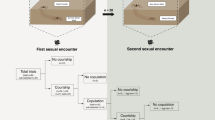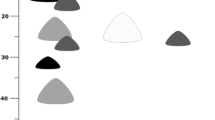Summary
Experimental observations on the arrenotokous reproductive patterns of two spider mite species (Acari: Tetranychidae), the long-seta form ofSchizotetranychus celarius (Banks) andTetranychus urticae Koch, revealed that reproduction of unfertilized females of the former is very differnt from that of the latter. Unfertilized females ofS. celarius, which has a subsocial life, laid a few eggs and then became inactive. In contrast, the fecundity of unfertilizedT. urticae females was only slightly reduced as compared with fertilized females. Mother-son matings may thus sometimes occur in naturalS. celarius populations.
A two-year field survey revealed that, in the absence of males, overwintering females ofS. celarius occasionally remain unfertilized until early spring. Furthermore, nest foundation observed in late spring indicated that most of the season's first nests were founded by single females. These two sets of observations strongly suggest that motherson mating takes places in nature, corresponding to the reproductive trait seen in the experiment.
Mother-son mating inevitably increases the relatedness between nest members. The estimated father's relatedness to its offspring is extraordinarily high under such condition. The possibility that kin-selection in the long seta-form ofS. celarius led to subsociality, especially paternal care, is suggested.
Similar content being viewed by others
References
Charnov, E. L. (1982)The theory of sex allocation.Monographs in population biology 18. Princeton University Press, Princeton, New Jersey.
Crozier, R. H. (1985) Adaptive consequences of male-haploidy. 201–222. InW. Helle andM. W. Sabelis (eds)Spider mites Vol. 1A. Elsevier, Amsterdam.
Fisher, R. A. (1930)The genetical theory of natural selection. Dover Publication, New York (first published by Oxford University Press, London).
Grafen, A. (1985) A geometric view of relatedness. 28–89. InR. Dawkins andM. Ridley (eds)Oxford surveys in evolutionary biology Vol. II. Oxford Univ. Press, Oxford.
Hamilton, W. D. (1964) Extraordinary sex ratio.Science 16: 477–488.
Hamilton, W. D. (1972) Altruism and related phenomena, mainly in social insects.Ann. Rev. Ecol. Syst. 3: 193–232.
Hartl, D. L. (1971) Some aspects of natural selection in arrhenotokous population.Amer. Zoologist 11: 309–325.
Helle, W. (1965) Inbreeding depression in an arrhenotokous mite (Tetranychus urticae Koch).Entomol. Exp. Appl. 8: 299–304.
Helle, W. (1967) Fertilization in the two-spotted spider mite.Entomol. Exp. Appl. 10: 103–110.
Helle, W. andP. W. Overmeer (1973) Variability in tetranychid mites.Ann. Rev. Entomol. 18: 97–120.
Oliver, Jr. J. H. (1971) Parthenogenesis in mites and ticks (Arachnida: Acari).Amer. Zoologist 11: 283–299.
Saitō, Y. (1979) Comparative studies on life histories of three species of spider mites (Acarina: Tetranychidae).Appl. Entomol. Zool. 14: 83–94.
Saitō, Y. (1986a) Biparental defence in a spider mite (Acari: Tetranychidae) infestingSasa bamboo.Behav. Ecol. Sociobiol. 18: 377–386.
Saitò, Y. (1986b) Prey kills predators: counter-attack success of a spider mite against its specific phytoseiid predator.Exp. Appl. Acrol. 2: 47–62.
Saitò, Y. andK. Takahashi (1982) Study on variation ofSchizotetranychus celarius (Banks) II. Comparison of mode of life between two sympatric forms (Acarina: Tetranychidae).Jpn. J. Ecol. 32: 69–78 (in Japanese with an English summary).
Saitò, Y. andJ. Ueno (1979) Life history studies onSchizotetranychus celarius (Banks) andAponychus corpuzae Rimando as compared with other tetranychid mite species (Acarina: Tetranychidae).Appl. Entomol. Zool.,14: 445–452.
Wilson, E. O. (1971)The Insect societies. The Belknap Press of Harvard University Press, Cambridge.
Wrensch, D. L. andS. S. Y. Young (1978) Effects of quality of resource and fertilization status on some fitness traits in the two-spotted spider mite,Tetranychus urticae Koch.Oecologia 18: 259–267.
Author information
Authors and Affiliations
Additional information
This study was supported in part by Grant-in-Aid No. 61540468 from the Ministry of Education, Science and Culture, Japan.
Rights and permissions
About this article
Cite this article
Saitō, Y. Extraordinary effects of fertilization status on the reproduction of an arrhenotokous and sub-social spider mite (Acari: Tetranychidae). Res Popul Ecol 29, 57–71 (1987). https://doi.org/10.1007/BF02515425
Issue Date:
DOI: https://doi.org/10.1007/BF02515425




